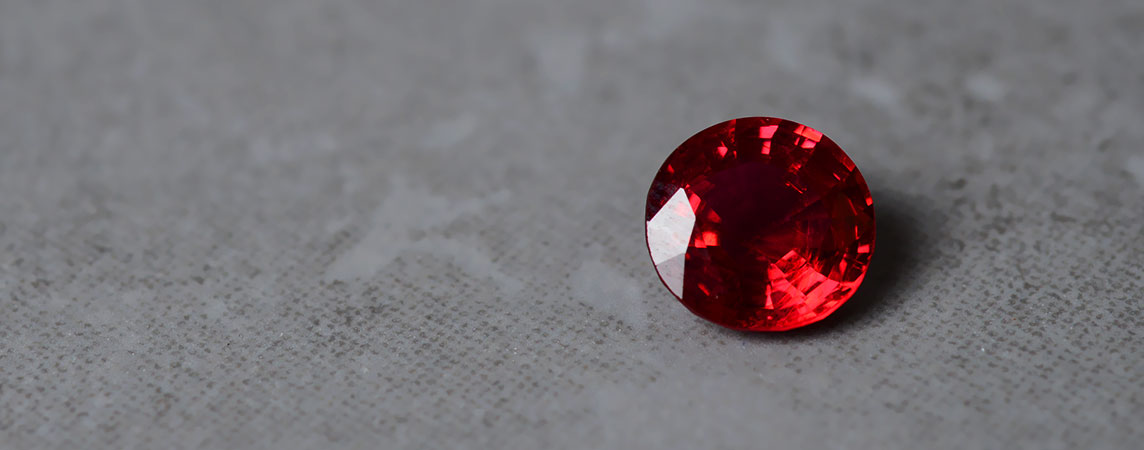Spinel
Known since antiquity, spinel has often been confused with ruby because of its exceptionally bright red color. This has not prevented it from occupying illustrious positions in the jewels of many sovereigns.
Spinel comes in such incredible, vivid colors as bright red, pink, orange, violet, blue and purple, with varying degrees of nuance. Philippe Tournaire likes to highlight this gem through original jewelry creations. For him, spinel is a stone of choice, because of its brilliance and beauty.
Identity card for a little-known gem
Spinel is a member of the oxide family. It has a hardness of 8 on the Mohs scale, making it a highly resistant gem appreciated at Jewellery. In its rough state, this surprising gem appears, like diamonds, in the form of a double pyramid with often well-defined contours. It also appears as a flattened crystal, which sometimes limits lapidaries who, in this case, cut the gem with a shallow breech, so as to lose as few carats as possible.
Where spinel comes from
This gem regularly forms alongside sapphires and rubies (which, in addition to its color, helps explain the confusion it has caused). It is found mainly in Burma, Sri Lanka, Thailand, Tanzania and Tajikistan. Yellow gold spinel pendant
The color of spinels
Spinelcomes in many guises, the best-known and most coveted being its vibrant red. Philippe Tournaire appreciates the intensity and sparkle of a pinkish-red spinel, which enhances a color harmony and makes it even more festive. Some are a magical red, others orange-red or even an intense pinkish-red, and their warm tones are largely due to the presence of chromium. The more this chemical element is present during spinel formation, the brighter the color. In cooler tones, this gem can be blue, purple and violet, even bluish green.
Until recently, it was thought that iron alone was responsible for the blue color of spinel. It has now been discovered that, in reality, it is the combination of iron and cobalt that allows our admiring eyes to contemplate the intense blues of these spinels, sourced mainly from Madagascar, Pakistan and Sri Lanka. Spinel, a gem still too little known by the general public, can be enigmatic, with different colors depending on the light shining on it (daylight or electric light), and can also be star-shaped, with 4 or 6 branches. White gold spinel ring.
Synthetic spinels
These gems have been synthesized since the early 20th century. You can spot a fake blue spinel by looking at its inclusions and testing it with gemmological instruments. Genuine blue spinels contain iron and cobalt, while fakes show no trace of iron, which can help distinguish them. Triplets are also available, consisting of two parts of colorless synthetic spinel, joined by a thin layer of colored glass. When viewed in profile, the 3 different layers can usually be distinguished.
The unusual story of a little-known gem
For centuries, spinel was mistaken for a very similar gem that grew up alongside it: ruby. It was only much later, in the 19th century, that spinel and ruby were separated into two distinct entities, thanks to scientific advances. The examples that follow show that a gem unknown at the time was nevertheless present in many sovereigns' ornaments, without them even knowing it...
Famous spinel jewels include :
- The Black Prince's "ruby": a 170carat spinel, today the jewel of the English crown. It once adorned the helmet of King Henry V at the Battle of Azincourt in 1415.
- Timour's "ruby" : an exceptional 361carat cabochon-cut spinel now owned by Queen Elizabeth of England. Persian inscriptions are engraved on this incredible gem, testifying to its age.
- The origin of the word spinel is a matter of debate: it could come from the Greek "spita" meaning "spark" or from the Latin "spina" meaning "thorn". The two origins could respectively refer to fire, to a spinel's bright red color and to its distinctive sharp crystals. Red spinel would symbolize power and courage. The blue spinel would enable its wearer to ward off negative energies.
Be that as it may, this unusual gem has made a name for itself among the greats, thanks to its beauty and sparkle. Recently recognized, it deserves to be appreciated for its sparkling colors, not always associated with ruby. Jewelry designer Philippe Tournaire invites us to discover this precious gem with its bewitching colors. Succumb to its singular charm that takes us on a journey, thinking of it as a real spinel and not a fake ruby!
The guarantee of uncompromising craftsmanship
OUR TITLES AND LABELS







